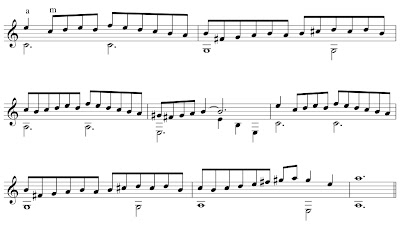I’ve been at this project four months, and my rest stroke alternation is no better than it was when I started. I suppose I could keep plugging away at what I’ve been doing. But at some point one has to make a concession to the shortness of human life. What I’ve done so far hasn’t worked, so it’s time to try something else.
Here’s a radical thought. Why not practice right hand alternation with music? You know, that pretty melodic stuff we hum as we go about our day? Wouldn’t that be a pleasant change of pace? And if I actually improve my right hand alternation, I’ll be doing it with, you know, real music. How nice that would be.
With that in mind, I’ve dusted off this old warhorse:
Guardame las vacas has several things to recommend it. It’s a standard right hand student piece, so anything I learn while practicing it becomes something I can use to help my students. Further, the scale passages are longer than a speed burst (remember, I’m increasingly skeptical of speed bursts), but have just enough breaks to avoid overworking my right shoulder. I also like that it has a bit of string crossing, but not enough to be a huge problem. Finally, I really enjoy playing it.
By the way, string crossing is often portrayed as a big deal in learning fast right hand alternation. I suspect, however, that it’s not nearly the hassle it’s made out to be. But since I don’t yet have good right hand alternation speed, it’s a bit presumptuous to say what is and isn’t an issue. So I’ll defer making any assertions for now.
Speaking of Guardame, here’s something intriguing. Some years ago one of my students played it in a student recital at the Cleveland Institute of Music. After the recital, someone from the audience—not a guitarist—told me how much she enjoyed my student’s performance of “Greensleeves.” Taken aback, I politely corrected her and told her the actual title of the piece. "Really?" she replied, "it sounds just like Greensleeves." I thought for a moment, and to my surprise she was right. The harmonic progressions of both Greensleeves and Guardame are virtually identical. Maybe musical historians are already aware of this, but I wasn’t.
I intend to begin each practice session with very slow playing of the first variation of Guardame. And by slow, I mean glacially slow—anything faster feels awful right now. Further, I’m going to focus on the feel rather than the appearance. If it feels good, do it. (I’m harking back to my “child of the 60’s” roots.) My goal is to find a good feel while playing real music, then ingrain it through repetition. I also suspect my raw finger strength might be a problem. So I’m going to revisit the “finger push-ups” described in an earlier post. Perhaps I now better understand their purpose.
An aside to those who wag their finger at me for using rest stroke in a renaissance piece. Yes, I know I’ll burn in hell. Now go away and leave me alone.
On a more general note, it still mystifies me that rest stroke alternation is such an elusive thing. But it does help explain at least some of the controversy surrounding rest stroke. From time to time, there are claims that free stroke can do everything that rest stroke can do, and thus rest stroke is unnecessary. Such claims are false, and there’s nothing quite so contentious as a debate between those who claim it’s so and those who claim it’s not. But if one can’t do rest stroke well, one might fool oneself into believing it’s unnecessary. Mind you, I make no charge of bad faith. I’ve no doubt these people honestly believe they’re on to something. Nonetheless, wrong is wrong, however honest it might be.
It’s time for another end of the month video report. I wish I had better things to show, but it is what it is. This video is very short: I play the Guardame variation very slow, and then it’s done. Also, I shot this video Sunday morning, and on Sunday mornings I refuse to do anything to make myself presentable. So if you have a weak stomach, consider yourself warned.
——[My next post will be on May 9, 2011.]——

No comments:
Post a Comment